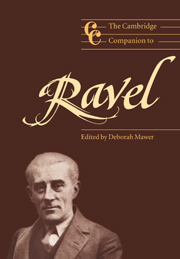Book contents
- Frontmatter
- Introduction
- Part I Culture and aesthetic
- Part II Musical explorations
- 4 Ravel and the piano
- 5 Harmony in the chamber music
- 6 Ravel and the orchestra
- 7 Ballet and the apotheosis of the dance
- 8 Vocal music and the lures of exoticism and irony
- 9 Ravel's operatic spectacles: L'Heure and L'Enfant
- Part III Performance and reception
- Appendix: Early reception of Ravel's music (1899–1939)
- Notes
- Select bibliography
- Index of names and works
6 - Ravel and the orchestra
from Part II - Musical explorations
Published online by Cambridge University Press: 28 September 2011
- Frontmatter
- Introduction
- Part I Culture and aesthetic
- Part II Musical explorations
- 4 Ravel and the piano
- 5 Harmony in the chamber music
- 6 Ravel and the orchestra
- 7 Ballet and the apotheosis of the dance
- 8 Vocal music and the lures of exoticism and irony
- 9 Ravel's operatic spectacles: L'Heure and L'Enfant
- Part III Performance and reception
- Appendix: Early reception of Ravel's music (1899–1939)
- Notes
- Select bibliography
- Index of names and works
Summary
Innovation in orchestration and genius in the handling of shape and colour are generally undervalued in broadly analytical studies of music, even in work on early twentieth-century music where, arguably, these factors were increasingly used to grant the coherence that pitch relationships were no longer able to provide. Pitch-centred analysis of modernist music has tended to regard music as independent of its medium, and has helped to build an aesthetic that treats works that depend on colour and shape, Ravel's Rapsodie espagnole for example, as less significant than those that directly confront the problems of tonality's supposed demise. Furthermore, the popularity of such pieces has meant that analysts have been denied their crusading role: they have not had to invoke complex methods to help secure the place of these compositions in the canon. Given the scope of this chapter, analyses must be brief, and will often give explications of form, thematic interconnections and post-tonal harmonic structures in the time-honoured way, but there will be a little more attention to register, shape and colour than normal, indicating the essential rather than secondary role of these parameters in Ravel's music.
Shéhérazade (overture)
Ravel's first orchestral work, Shéhérazade, ouverture de féerie, was conducted by its composer in its first and only performance until recent times on 27 May 1899. It was the first of only four orchestral pieces that did not begin their lives as piano works or as ballets. I will consider these in the first part of this chapter and then proceed to Ravel's transcriptions.
- Type
- Chapter
- Information
- The Cambridge Companion to Ravel , pp. 118 - 139Publisher: Cambridge University PressPrint publication year: 2000
- 3
- Cited by



